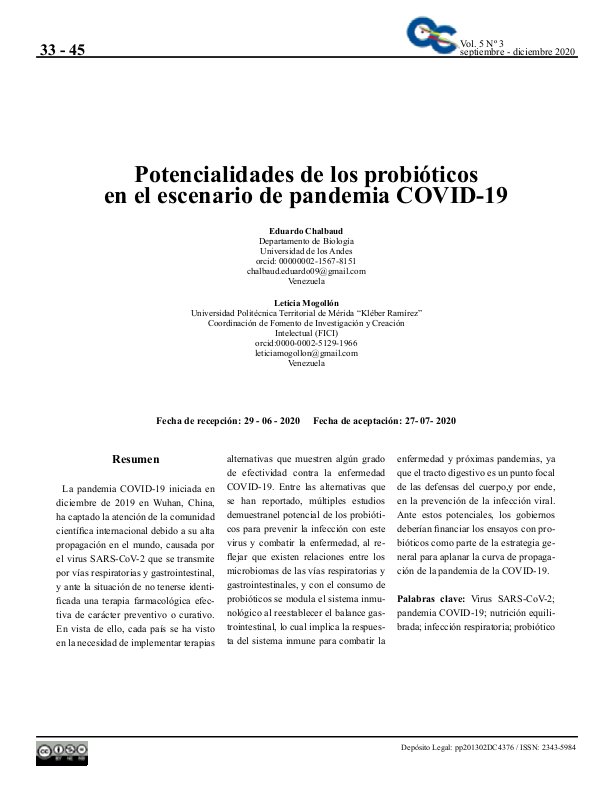Potencialidades de los probióticos en el escenario de pandemia COVID-19
Palabras clave:
Virus SARS-CoV-2; pandemia COVID-19; nutrición equilibrada; infección respiratoria; probióticoResumen
La pandemia COVID-19 iniciada en diciembre de 2019 en Wuhan, China, ha captado la atención de la comunidad científica internacional debido a su alta propagación en el mundo, causada por el virus SARS-CoV-2 que se transmite por vías respiratorias y gastrointestinal, y ante la situación de no tenerse identificada una terapia farmacológica efectiva de carácter preventivo o curativo.En vista de ello, cada país se ha visto en la necesidad de implementar terapias alternativas que muestren algún grado de efectividad contra la enfermedad COVID-19. Entre las alternativas que se han reportado, múltiples estudios demuestranel potencial de los probióticos para prevenir la infección con este virus y combatir la enfermedad, al reflejar que existen relaciones entre los microbiomas de las vías respiratorias y gastrointestinales, y con el consumo de probióticos se modula el sistema inmunológico al reestablecer el balance gastrointestinal, lo cual implica la respuesta del sistema inmune para combatir la enfermedad y próximas pandemias, ya que el tracto digestivo es un punto focal de las defensas del cuerpo,y por ende, en la prevención de la infección viral. Ante estos potenciales, más gobiernos deberían financiar los ensayos con probióticos como parte de la estrategia general para aplanar la curva de propagación de la pandemia de la COVID-19.
Descargas
Citas
Baud, D., V. Dimopoulou, G. Gibson, G. Reid, and Giannoni E. (2020). Using Probiotics to Flatten the Curve of Coronavirus Disease COVID-2019 Pandemic. Frontiers in Public Health: 8: Article186.
Bergmann, R., Pereira, M., Veiga, S., Schneedorf, J., de Mello Silva Oliveira, N., & Fiorini, J. (2010). Microbial profile of a kefir sample preparations - grains in natura and lyophilized and fermented suspension. FoodScience and Technology (Campinas) pp. 1022-1026.
Bermudez-Brito M, Plaza-Diaz J, Munoz-Quezada S, Gomez-Llorente C, Gil A. (2012). Probiotic mechanisms of action. Ann NutrMetab., 61:160–74.
Bertelli C, Pillonel T, Torregrossa A, SimonsenGS, Støen R, Klingenberg C. (2015). Bifidobacteriumlongum bacteremia in preterm infants receiving probiotics. Clin Infect Dis. 60:924–7
Bo, L., J. Li, T. Tao, Y. Bai, X. Ye, and R. Hotchkiss. (2014). Probiotics for preventing ventilator-associated pneumonia. Cochrane Data base Syst: 10:CD009066.
Boldrini, G .(2009). Consumo de Kéfir y frecuencia evacuatoria. Tesis de Licenciatura, FASTA: Universidad FASTA, Facultad de Ciencias de la Salud, Licenciatura en Nutrición.
Chong HX, Yusoff NAA, et al. .(2019). Lactobacillus plantarumDR7 improved upper respiratory tract infections via enhancing immune and inflammatory parameters: a randomized, double-blind, placebo-controlled study. J Dairy Sci.102:4783–97.
De las Cagigas Reig, A., and J Blanco Anesto. (2002). Prebióticos y probióticos, una relación beneficiosa”." Revista Cubana de Alimentación y Nutrición, 16(1):63-8.
Dermyshi, E., Y. Wang, C. Yan, W. Hong, G. Qiu, and X. Gong. (2017). The “golden age” of probiotics: a systematic review and meta-analysis of randomized and observational studies in preterm infants. Neonatology, 112:9–23.
De Vrese M, Winkler P, Rautenberg P, Harder T, Noah C, Laue C, et al. (2005). Effect of Lactobacillus gasseri PA 16/8, BifidobacteriumlongumSP 07/3, B. bifidum MF 20/5 on common cold episodes: a double blind, randomized, controlled trial. ClinNutr. 24:481–91.
Di Pierro F. (2020). A possible probiotic (S. salivariusK12) approach to improve oral and lung microbiotas and raise defenses against SARS-CoV-2. Minerva Med.
Enaud R, Prevel R, Ciarlo E, Beaufils F, Wieërs G, Guery B, et al. (2020). The gut-lung axis in health and respiratory diseases: a place for inter-organ and inter-kingdom crosstalks. Front Cell Infect Microbiol. 10:9.
Frazier, W., Westhoff, D. (1993). Microbiología de los alimentos, España, Editorial AcribiaSA.
García, M., Quintero, R. y López, A.(2004). Biotecnología Alimentaria. México: Limusa, S.A.
GaoQY, Chen YX, Fang JY. ( 2019) Novel coronavirus infection and gastrointestinal tract. J Dig Dis. 2020:12:3.
Goldenberg JZ, Yap C, Lytvyn L, Lo CK, Beardsley J, Mertz D. (2017). Probiotics for the prevention of Clostridium difficile-associated diarrhea in adults and children. Cochrane Data base Syst Rev.
Gonzalez-Ochoa G, Flores-Mendoza LK, Icedo-Garcia R, Gomez-Flores R, Tamez-Guerra P. (2017). Modulation of rotavirus severe gastroenteritis by the combination of probiotics and prebiotics. Arch Microbiol., 2017:199:953–61.
Gu J., Han B., Wang J. (2020).COVID-19: Gastrointestinal manifestations and potential fecal-oral transmisión. Gastroenterology. Recuperadoen :doi: https://doi.org/10.1053/ j.gastro.2020.02.054
Guo Q, Goldenberg JZ, Humphrey C, El Dib R, Johnston BC. (2019). Probiotics for the prevention of pediatric antibiotic-associated diarrhea. Cochrane Database Syst Rev.
Hill, C., F. Guarner, G. Reid, GR. Gibson, DJ. Merenstein, and Bl. Pot. (2014). Expert consensus document. The International Scientific Association for Probiotics and Prebiotics consensus statement on the scope and appropriate use of the term probiotic. Nat Rev Gastroenterol Hepatol, 2014: 11:506–14.
Jin, X., JS.Lian, JH. Hu, J. Gao, L. Zheng, and YM. Zhang. (2020). Epidemiological, clinical and virological characteristics of 74 cases of coronavirus-infected disease 2019 (COVID-19) with gastrointestinal symptoms. China: Gut.
Kolacek S, Hojsak I, BerniCanani R, Guarino A, Indrio F, Orel R, et al. (2017). Commercial probiotic products: a call for improved quality control. A position paper by the ESPGHAN Working Group for Probiotics and Prebiotics J. Pediatric Gastroenterol Nutr. 2017: 65:117–24.
Kotzampassi, K., E. Giamarellos-Bourboulis, A. Voudouris, P. Kazamias, and E. (2006)Eleftheriadis. "Benefits of a synbiotic formula (Synbiotic2000Forte) in critically Ill trauma patients: early results of a randomized controlled trial." World J Surg., 2006: 30:1848–55.
Lehtoranta L, Kalima K, He L, Lappalainen M, Roivainen M, Närkiö M, et al. (2014). Specific probiotics and virological findings in symptomatic conscripts attending military service in Finland. J ClinVirol., 2014: 60:276–81.
Levin, R. (2018). Probiotics: The First 10000 Years. In Probiotic Dairy Products, by Adnan Y. Tamime, 17-36.U.S.A: John Wiley & Sons Ltd, 2018.
Li H., Wang YM., XuJY., Cao B. (2020). [Potential antiviral therapeutics for 2019 Novel Coronavirus].ZhonghuaJie He He Hu Xi ZaZhi. 43(3), pp. 170-172.
Lin, L., X. Jiang, Z. Zhang, S. Huang, Z. Zhang, and Z. Fang. (2020). Gastrointestinal symptoms of 95 cases with SARS-CoV-2 infection. China: Gut.
Luoto R, Ruuskanen O, Waris M, Kalliomaki M, Salminen S, Isolauri E. (2014). Prebiotic and probiotic supplementation prevents rhinovirus infections in preterm infants: a randomized, placebo-controlled trial. J Allergy Clin Immunol, 2014: 133:405–13.
Machado, A., M. Lemos, R. Silva, A. Soares, J. Trajano, and V. Fllosi. (2013) Microbiological, technological and therapeutic properties of kefir: a natural probiotic beverage. Brazilian Journal of Microbiology (Brazilian Journal of Microbiology.), 2013: 44 (2), 341-349.
Madigan, M., J. MarTinko, K. Bender, D. Buckley, and D. Stahl. (2015). Brock biology of microorganisms. New York: Pearson, 2015.
Montville, T, y Matthews, K. (2007). Growth, Survival, and Death of Microbes in Foods. En Food microbiology : fundamentals and frontiers, de M. Doyle y L. Beuchat, 3-22. Center for Food Safety, The University of Georgia, Griffin: American Society for Microbiology.
Metchnikoff, E. (1904).Chapter X. In The Nature of Man, by Wm Heinemann, 248. London: WmHeinemann.
Ng SC, T. (2020). COVID-19 and the gastrointestinal tract: more than meets the eye. China: Gut. doi: 10.1136/gutjnl--3 21195. [Epub ahead of print].
Pan, Y., D. Zhang, P. Yang, LL. Poon, and Q. Wang. (2020). Viral load of SARSCoV-2 in clinical samples. Lancet Infect Dis., 2020: 20:411–2.
Panigrahi P, Parida S, Nanda NC, Satpathy R, Pradhan L, Chandel DS, et al. A randomized synbiotic trial to prevent sepsis among infants in rural India.Nature. 2017: 548:407–12.
Pattacini, A. (2020). Alimentos funcionales: Prebióticos. 27 de Diciembre de 2008. http://www.nutrar.com/detalle.asp?ID=569.
Plaza, J. (2019). Proceso de elaboración del kéfir y su aplicación gastronómica. Proyecto de intervención previo a la obtención del título de Licenciado en Gastronomía y Servicio de Alimentos y Bebidas, Cuenca: Universidad de Cuenca. Facultad de ciencias de la Hospitalidad. Carrera de Gastronomía.
Rodriguez, J., J. Noriega, A. Lucero, and A. Tejeda. (2017) Avances en el estudio de la bioactividad multifuncional del kéfir. Interciencia: 42(6), 347-354.
SaavedraJM, Bauman NA, Oung I, Perman JA, Yolken RH. (1994). Feeding of Bifidobacteriumbifidum and Streptococcus thermophilus to infants in hospital for prevention of diarrhoea and shedding of rotavirus. Lancet, 344:1046–9.
Sencio V, Barthelemy A, Tavares LP, Machado MG, Soulard D, Cuinat Cl. (2020). Gut dysbiosis during influenza contributes to pulmonary pneumococcal superinfection through altered short-chain fatty acid production. 30:2934–47
Su M, Jia Y, Li Y, Zhou D. and J. Jia. (2020). Probiotics for the prevention of ventilatorassociated pneumonia: a meta-analysis of randomized controlled trials. Respir Care, 65:5.
Shimizu K, Yamada T, Ogura H, Mohri T, Kiguchi T, Fujimi S. (2018). Synbiotics modulate gut microbiota and reduce enteritis and ventilatorassociated pneumonia in patients with sepsis: a randomized controlled trial.Crit Care. 22:239.
Szajewska H, Kolodziej M, Gieruszczak-Bialek D, Skorka A, Ruszczynski M, Shamir R.(2019). Systematic review with meta-analysis: Lactobacillus rhamnosusGG for treating acute gastroenteritis in children–a 2019 update. Aliment Pharmacol Ther. 49:1376–84.
Tannock GW. (199). Identification of lactobacilli and bifidobacteria. Curr. Issues Mol. Biol.; 1: 53–64.
TannockGW, Munro K, HarmsenHJ, Welling GW, Smart J, and Gopal PK. (2000). Analysis of the fecal microflora of human subjects consuming a probiotic product containing Lactobacillus rhamnosus DR20. Appl. Environ. Microbiol; 66: 2578–2588
Trivedi, P., S. Pandey, and S. Bhadauria. (2010). Text book of microbiology. India: Aavishkar Publishers.
Waki N, Matsumoto M, Fukui Y, Suganuma H. (2014). Effects of probiotic Lactobacillus brevisKB290 on incidence of influenza infection among schoolchildren: an open-label pilot study. LettAppl Microbiol. 59:565–71.
Wu, F., A. Xiao, J. Zhang, X. Gu, WL. Lee, and K. Kauffman. (2020). SARS-CoV-2 titers in wastewater are higher than expected from clinically confirmed cases. China: medRxiv.
Xu K, Cai H, Shen Y, Ni Q, Chen Y, Hu S, et al.(2020). Management of corona virus disease-19 (COVID-19): the Zhejiang experience. Zhejiang Da Xue Xue Bao Yi Xue Ban.,49.

Descargas
Publicado
Cómo citar
Número
Sección
Licencia

Esta obra está bajo una licencia internacional Creative Commons Atribución-SinDerivadas 4.0.







